Serving 1,603 students in grades 9-12, Elyria High School ranks in the bottom 50% of all schools in Ohio for overall test scores (math proficiency is bottom 50%, and reading proficiency is bottom 50%).
The percentage of students achieving proficiency in math is 18% (which is lower than the Ohio state average of 52%). The percentage of students achieving proficiency in reading/language arts is 41% (which is lower than the Ohio state average of 60%).
The student:teacher ratio of 14:1 is lower than the Ohio state level of 17:1.
Minority enrollment is 57% of the student body (majority Black), which is higher than the Ohio state average of 34% (majority Black and Hispanic).
Quick Stats (2025)
- Grades: 9-12
- Enrollment: 1,603 students
- Student:Teacher Ratio: 14:1
- Minority Enrollment: 57%
- Graduation Rate: 87% (Btm 50% in OH)
- Overall Testing Rank: Bottom 50%
- Math Proficiency: 18% (Btm 50%)
- Reading Proficiency: 41% (Btm 50%)
- Science Proficiency: 55% (Btm 50%)
- Source: National Center for Education Statistics (NCES), OH Dept. of Education
Top Rankings
Elyria High School ranks among the top 20% of public schools in Ohio for:
Category
Attribute
Diversity
School Overview
Elyria High School's student population of 1,603 students has declined by 11% over five school years.
The teacher population of 115 teachers has grown by 6% over five school years.
Grades Offered
Grades 9-12
Total Students
1,603 students
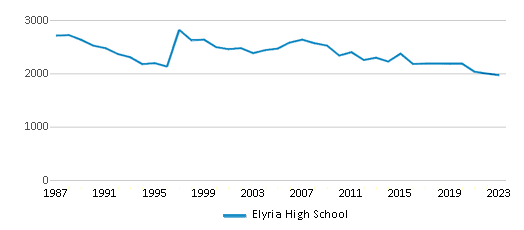
Gender %
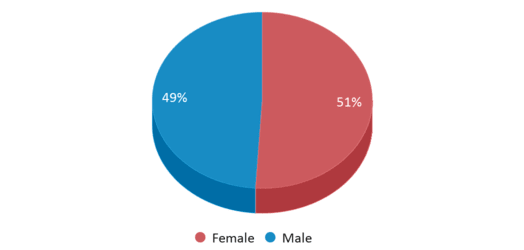
Total Classroom Teachers
115 teachers
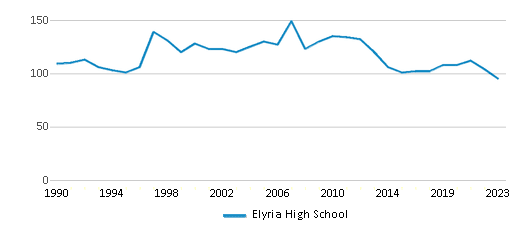
Students by Grade
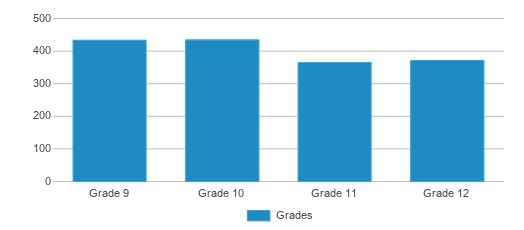
School Rankings
Elyria High School ranks within the bottom 50% of all 3,241 schools in Ohio (based off of combined math and reading proficiency testing data).
The diversity score of Elyria High School is 0.72, which is more than the diversity score at state average of 0.53. The school's diversity has stayed relatively flat over five school years.
Overall Testing Rank
#2647 out of 3241 schools
(Bottom 50%)
(Bottom 50%)
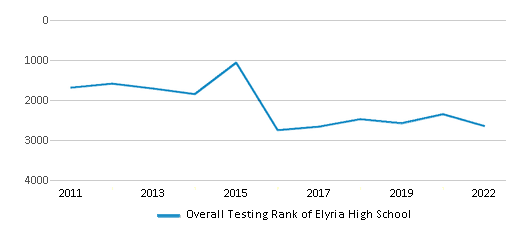
Math Test Scores (% Proficient)
18%
52%

Reading/Language Arts Test Scores (% Proficient)
41%
60%
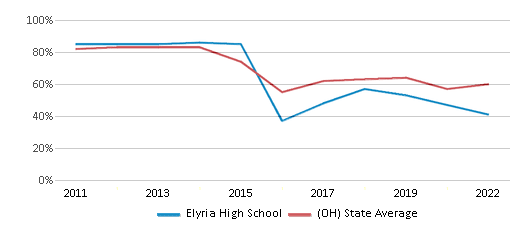
Science Test Scores (% Proficient)
55%
63%
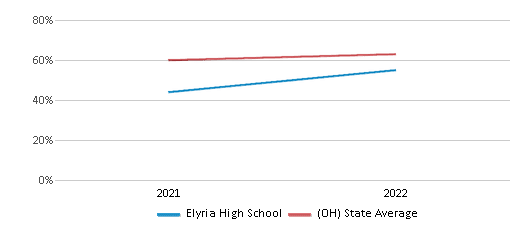
Student : Teacher Ratio
14:1
17:1
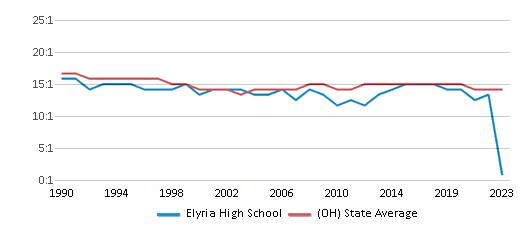
American Indian
n/a
n/a
Asian
1%
3%
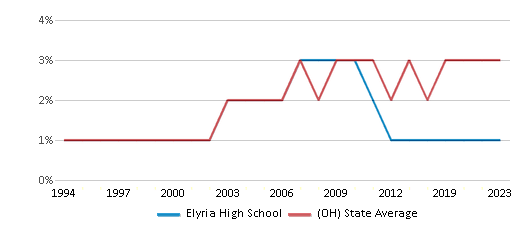
Hispanic
16%
8%
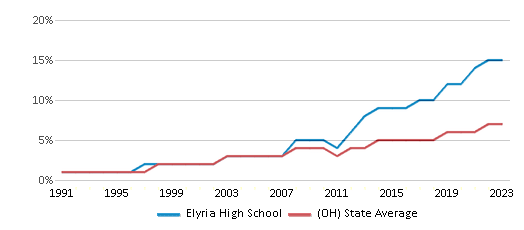
Black
21%
17%
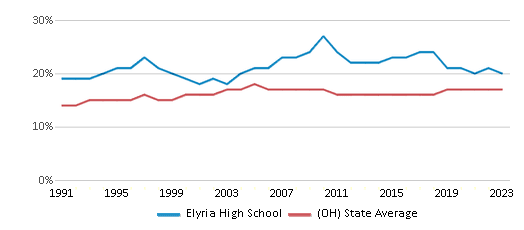
White
43%
66%
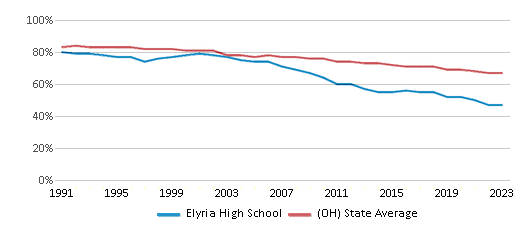
Hawaiian
n/a
n/a
Two or more races
19%
6%
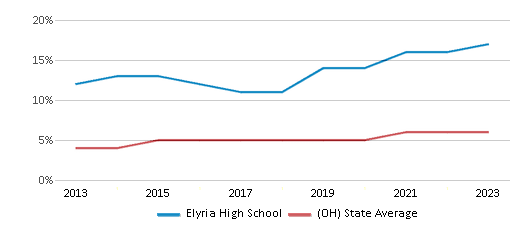
All Ethnic Groups
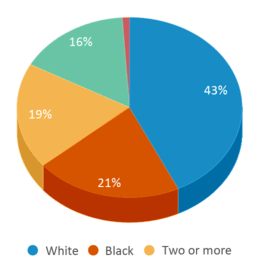


Graduation Rate
87%
86%
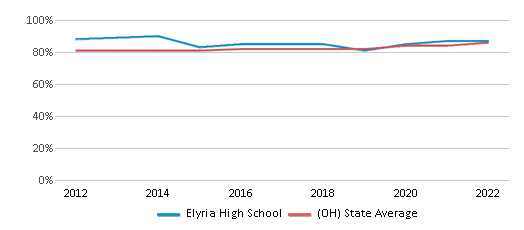
Participates in the National School Lunch Program (NSLP)
Yes
Eligible for Free Lunch
65%
42%
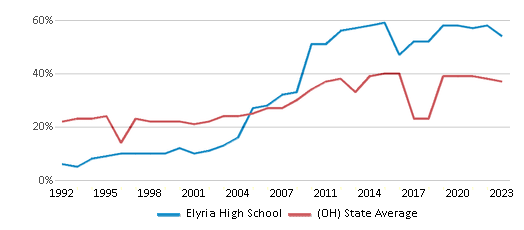
Eligible for Reduced Lunch
10%
5%
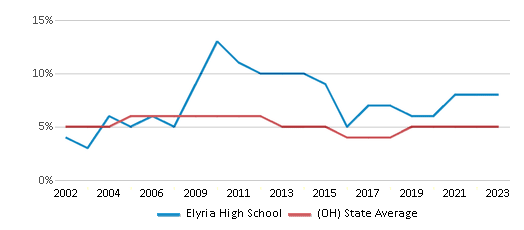
School Statewide Testing
School District Name
Source: National Center for Education Statistics (NCES), OH Dept. of Education
Profile last updated: 02/09/2025
Frequently Asked Questions
What is Elyria High School's ranking?
Elyria High School is ranked #2647 out of 3,241 schools, which ranks it among the bottom 50% of public schools in Ohio.
What schools are Elyria High School often compared to?
Elyria High Schoolis often viewed alongside schools like Lorain High School by visitors of our site.
What percent of students have achieved state testing proficiency in math and reading?
18% of students have achieved math proficiency (compared to the 52% OH state average), while 41% of students have achieved reading proficiency (compared to the 60% OH state average).
What is the graduation rate of Elyria High School?
The graduation rate of Elyria High School is 87%, which is higher than the Ohio state average of 86%.
How many students attend Elyria High School?
1,603 students attend Elyria High School.
What is the racial composition of the student body?
43% of Elyria High School students are White, 21% of students are Black, 19% of students are Two or more races, 16% of students are Hispanic, and 1% of students are Asian.
What is the student:teacher ratio of Elyria High School?
Elyria High School has a student ration of 14:1, which is lower than the Ohio state average of 17:1.
What grades does Elyria High School offer ?
Elyria High School offers enrollment in grades 9-12
What school district is Elyria High School part of?
Elyria High School is part of Elyria City Schools School District.
School Reviews
5 1/6/2020
Bathrooms very good. Dropped a few deuces in the toilets last week. Very nice, very good, very clean.
3 12/16/2019
Lots of opportunities to take college or AP classes, or if the student has learning disabilities or needs extra help, classes are tailored for that as well. Many of the teachers care about their students. Very large and diverse student body. Opportunities are available for people interested in music and art as well as computer classes. Better sports organization is needed as well as more sports to choose from. There are many clubs that cater to different students' needs and identities. The security guards are not the best, however, and there have been some reports or rumors of relationships between students and guards (less prevalent than before). The school could do a better job with making sure their students are more hygienic (there are a good amount of children who come in dirty and with bedbugs). But if a family is looking for a school that is diverse and has various levels of classes, look no further than Elyria.
1 1/17/2018
Overcrowded and unorganized
Review Elyria High School. Reviews should be a few sentences in length. Please include any comments on:
- Quality of academic programs, teachers, and facilities
- Availability of music, art, sports and other extracurricular activities
Recent Articles

What Is A Charter School?
Explore the world of charter schools in this comprehensive guide. Learn about their history, how they operate, and the pros and cons of this educational innovation. Discover key facts about charter schools, including admission policies, demographics, and funding, as well as what to look for when considering a charter school for your child.

10 Reasons Why High School Sports Benefit Students
Discover the 10 compelling reasons why high school sports are beneficial for students. This comprehensive article explores how athletics enhance academic performance, foster personal growth, and develop crucial life skills. From improved fitness and time management to leadership development and community representation, learn why participating in high school sports can be a game-changer for students' overall success and well-being.

February 05, 2025
Understanding the U.S. Department of Education: Structure, Impact, and EvolutionWe explore how the Department of Education shapes American education, from its cabinet-level leadership to its impact on millions of students, written for general audiences seeking clarity on this vital institution.









